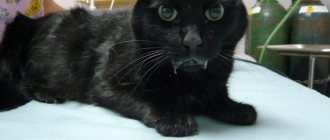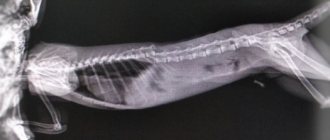Vomiting in a cat is a reflexive eruption of the contents of the stomach, and in some cases the duodenum, through the mouth.
There are two types of vomiting: acute and chronic. Vomiting that lasts up to two days is considered acute. Chronic for more than 2 weeks.
The causes of vomiting in a cat can be very different; most often it is provoked by diseases of the gastrointestinal tract, but this clinical symptom can accompany a number of other diseases.
How to recognize vomiting?
Vomiting is a complex mechanism that usually begins with a stage of nausea in which the cat appears restless, and is often accompanied by salivation, repeated swallowing, and assuming a comfortable position.
Vomiting itself involves strong contractions of the abdominal muscles, expelling fluid, foam, or food. The intense effort involved in this process can be distressing for your cat.
It is important to be able to differentiate vomiting from coughing. Cats may cough up some foam or foamy material, which they subsequently swallow. When coughing, cats typically squat on all four legs with their necks extended. Your veterinarian can help you differentiate coughing from vomiting with video.
What diseases can there be?
Based on the symptoms, the veterinarian will be able to determine what the pet is sick with and prescribe the necessary treatment. Diseases that cause vomiting after eating include:
- Gastritis;
- Ulcer;
- Colitis;
- Pancreatitis;
- Intestinal pathologies (tumors, obstruction, unstable blood supply);
- Helminths.
To determine more precisely, it will be necessary to do an ultrasound of the gastrointestinal tract and undergo tests. After this, the veterinarian will be able to tell exactly what’s wrong with the pet and prescribe medications. There is no need to treat a cat yourself after learning his diagnosis; human medicines will not suit him, but, on the contrary, will ruin the body. If the doctor said that there are no threats and the pet is healthy, then you just need to reduce portions, drink more water and eat special grass. The cat needs grass to help its digestive system rest from food and cleanse itself.
Causes of vomiting in cats
There are many reasons why a cat vomits. This could be overeating, poor-quality products, diseases of the gastrointestinal tract, abdominal organs, metabolic diseases, parasitic infestations, tumors, infectious diseases, etc. The contents of vomit and color help determine the causes.
The cat is throwing up hair
One of the most common is hairball vomiting. This problem occurs in long-haired cat breeds that are prone to active grooming.
Although hairballs are common in cats, they are not actually normal. A healthy cat will spend most of its time grooming itself, but will also remove and ingest hair without disrupting hairball evacuation. However, some cats accumulate so much hair in their digestive tract that it can cause intestinal obstruction.
These hairballs are caused by the ingestion of excess hair as a result of vigorous, over-grooming or due to problems moving hair through the digestive tract system (which can occur with gastrointestinal conditions).
Cat vomits after eating
By nature, a cat is a predatory animal, so its body needs frequent meals in small portions. Eating large quantities of food quickly and overeating leads to the cat vomiting food. Fractional feeding according to the diet manufacturer's norm copes with this problem.
What does white vomit in a cat mean?
Vomiting foam in a cat is not dangerous if it is a one-time occurrence. This happens in young kittens when they switch to solid food. In adult cats, white foam vomiting may occur when changing the type of food. If a cat vomits foam regularly, this may indicate a disorder in the gastrointestinal tract. For example, with developing gastritis, a cat vomits foam in the morning.
Why does a cat vomit liquid?
Most often, clear vomiting occurs due to parasites. In addition, the cause of such vomiting may be swallowed fur, which irritates the walls of the esophagus. But if you frequently vomit liquid, you should pay attention to other signs and consult a doctor, because this is one of the symptoms of kidney disease, thyroid disease, and even the development of tumors.
What to do if your cat vomits water?
Some cat owners may describe their cat as “vomiting,” but it should be noted that frequent vomiting is never normal for a cat. Vomiting more than once a week is definitely a sign of a problem. If your cat is vomiting clear liquid or water multiple times and/or in combination with other symptoms such as lack of appetite, weight loss, lethargy, or diarrhea, you should make an appointment with your veterinarian immediately. Your veterinarian will want to start with a physical examination, checking your cat's vital signs and palpating her abdomen. After a thorough examination, your veterinarian may also want to run some tests, including blood work and x-rays. A blood test will test your cat's organ function to make sure there are no signs of liver or kidney disease, as well as determine your cat's red blood cell and platelet levels.
Depending on what your doctor finds, your cat may require hospitalization for fluid therapy and supportive care, or she may only require outpatient treatment and oral medications to return home. If your vet suspects your cat has an intestinal obstruction, she may need surgery to remove the obstruction.
Author of the article: Tabitha Kuchera . Tabitha is a Level 3 RVT, CCBC and KPA-CTP certified, Level 3 Fear Free- and Low Stress Handling certified, and is proficient in cat behavior counseling and training, and positive affection counseling and behavior training for dogs.
When should you contact a veterinarian? How to treat vomiting in a cat?
Vomiting in a pet in itself is a reason to consult a doctor.
Acute vomiting may be accompanied by depression of the general condition, dehydration, and pain, which requires emergency intervention by a veterinarian.
Acute vomiting in a cat can most often be associated with diseases such as:
- pancreatitis
- gastritis
- foreign objects in the digestive tract
- diseases of the hepatobiliary system
- food intolerance, etc.
Internal bleeding
It is necessary to take the cat to the veterinarian if the temperature has risen, the mucous membrane has acquired an unnatural shade, and the expelled masses contain dark red or brown clots. Similar symptoms occur with gastric bleeding caused by:
- toxic substances;
- progression of helminthiasis;
- perforation of the ulcer;
- disintegration of the neoplasm.
With vomiting, the animal releases brown liquid, the stool has a color and consistency similar to coffee grounds due to bleeding in the intestines. Red sputum is released from the mouth when the respiratory tract is damaged by a sharp object. If the owner himself managed to rid the cat of vomiting blood, treatment and observation by a veterinarian is required when the condition worsens, which manifests itself:
- enlarged abdomen;
- blanching of mucous membranes;
- change in behavior.
The pet's fur stops shining and falls out. The playful creature becomes lethargic and does not want to eat.
How to treat vomiting in a cat?
Chronic, periodic vomiting can also be a symptom of many diseases, both directly related to the gastrointestinal tract and metabolic disorders occurring in the body. Common reasons:
- inflammatory diseases of the digestive tract
- food allergy
- intestinal neoplasia
- chronic pancreatitis
- diabetes
- chronic kidney disease
- hyperthyroidism and others
Additional diagnostics to determine the causes of vomiting in a cat
Often, to identify the cause, your doctor may need additional diagnostic methods, namely:
- Blood tests (clinical, biochemical) can indicate the presence of problems in metabolic disorders, functional disorders of internal organs.
- X-ray examination - can help in excluding or confirming the presence of foreign objects, problems with the upper gastrointestinal tract.
- Ultrasound is another method for examining the stomach and intestines. Ultrasound is capable of detecting obstructions, identifying inflammatory processes, identifying neoplastic processes, etc.
- An endoscopic examination is a test that allows you to view the inside of the stomach and duodenum directly through an endoscope (a flexible viewing tube). This procedure is necessary, for example, if the cat vomits after eating.
For each patient at the Dr.Hug veterinary center, the veterinarian selects an individual diagnostic and treatment plan after examination and medical history.
How to feed correctly?
A pet will not drink vitamins if they are lacking, so all the vitamins and minerals it needs must be present in the food. The animal needs balanced food. How to feed your furry friend correctly, how to make sure that the animal receives with food everything it needs for proper development and good health?
- First, the amount of food should be limited. You need to feed the animal 2-3 times, in the morning and in the evening, but you can skip lunch. Portions should be approximately the same size each time. It is better to put in less food and then add it later, rather than the animal overeating and becoming ill.
- Secondly, the food must be of high quality. High quality does not mean expensive. You can boil the animal’s meat yourself, adding carrots and other vegetables. If you don’t want to cook separately for your cat, then you should contact your veterinarian for advice; he will be able to tell you exactly what food is suitable for a particular breed.
- Thirdly, the water in the bowl must be clean. You need to change and add water at least twice a day, it is better to do this in the morning and evening. Your furry friend should always have water. There is no need to experiment and pour mineral water with gases into your cat. The cat will not drink water, and he will have to sit without water all day, which is fraught with negative consequences for his body.
- Fourthly, a four-legged friend needs grass. You can buy seeds for such grass at any pet store; it is inexpensive, grows quickly, and looks like a lawn. Cats love this simple green grass.
- Fifthly, your pet’s diet must include fish. Fish contains useful microelements that a cat needs as a predator.
- Sixth, if a favorite predator eats what its owner eats (some cats love apples, cucumbers and other foods), there is no need to wean him off. This means that the beneficial substances contained in these products are necessary for the predator.
Creating the right diet for a cat is not difficult. The main thing is to monitor your pet’s well-being, carefully read the composition of the food he eats, listen to the veterinarian’s recommendations and add variety to your pet’s diet.
Vomiting in a cat is a fairly common phenomenon. Periodically, our pets cleanse their stomachs in this way and get rid of discomfort. But sometimes it can be a clear sign of something wrong with the body, such as when your cat vomits yellow liquid. Every loving owner should learn to distinguish a natural urge from one caused by a disease. In most cases, with adequate assistance, the illness goes away quickly and without any consequences.
Symptoms that indicate you need to take your cat to the vet
Yellow vomiting in a cat, which occurs once after eating food, while the general condition and activity of the animal has not changed, is not a cause for concern and, most likely, indicates that the pet simply overate. You should contact your veterinarian in the following cases:
- yellow vomiting lasts for several hours;
- impurities of bile, bloody streaks or a huge amount of yellow mucus are clearly visible in the vomit;
- yellow vomiting in a cat is accompanied by an increase in general body temperature, a decrease in physical activity, and refusal to feed and drink;
- The animal vomits constantly, regardless of food intake.
What treatment is needed?
Often, simple vomiting in a kitten or young adult can be dealt with at home. If the discharge is profuse and causes you doubts, then do not delay going to the veterinarian. You should also see a doctor if your cat has vomited more than twice.
The first thing to do if your pet’s condition noticeably deteriorates is to prevent dehydration. To do this, offer your cat clean water every hour.
If there is a suspicion of ingestion of a foreign object, then you can independently examine the mouth and throat. Often hairballs or large pieces of food get stuck at the very top. In this case, it is not difficult to remove them yourself
After such a procedure, it is important to give the body a rest. Do not feed or water the animal for at least 12 hours; ice cubes will help quench thirst
Didn't he feel sick during the day? Try giving baby meat puree in small portions, 5-6 times a day. The diet must be followed for up to three days, then you can move on to your normal diet.
Sometimes it happens when an animal feels bad, but cannot vomit on its own. Then you can induce vomiting in one of the following ways:
- Give your cat a glass of slightly warm water, in which you must first dissolve a tablespoon of salt. It is necessary for the pet to drink quickly and in large sips.
- Place the cat on its side and lightly press the root of the tongue with a clean index finger.
!!! It is forbidden to induce vomiting if the animal has swallowed a sharp object. This can cause serious irritation of the esophagus.











